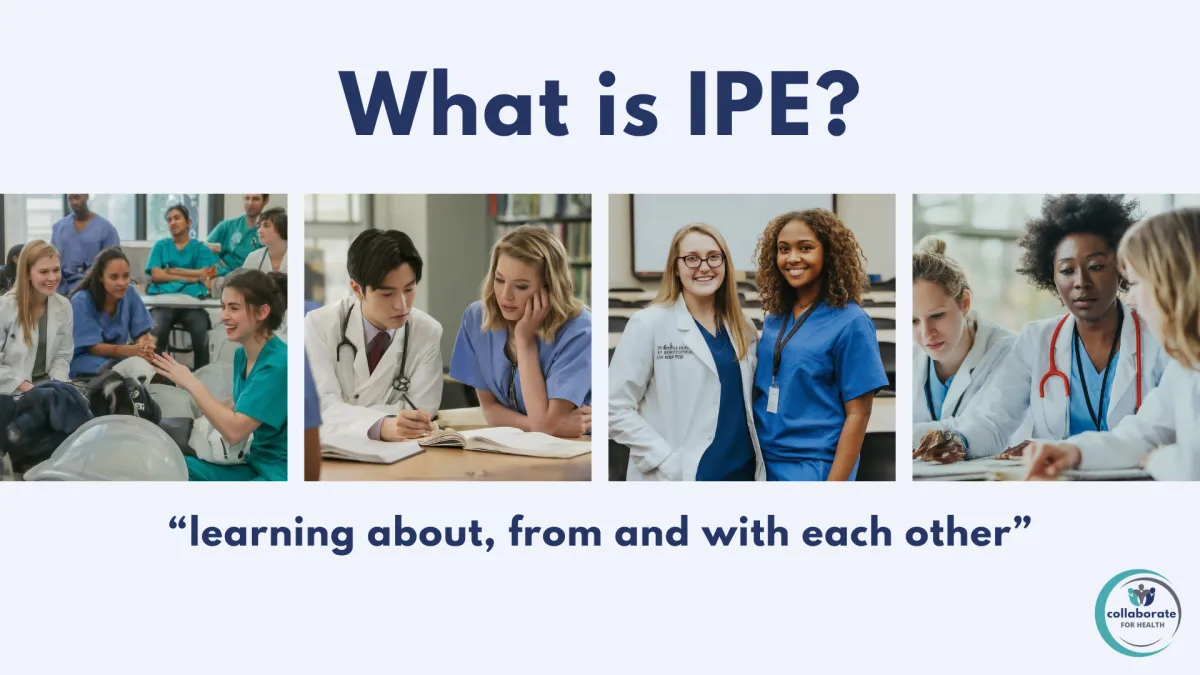BLOG
Welcome to Collaborate for Health, where we champion the power of collaboration to transform healthcare. Explore our collection of insightful articles and blogs, crafted to illuminate the benefits of teamwork in healthcare. From enhancing patient outcomes to streamlining administrative processes, our content is rich with valuable insights. Dive into a wealth of knowledge designed to inspire and inform. Take a moment to explore our website and unlock the potential of collaboration for a healthier future. Read the latest articles covering a variety of topics and perspectives on interprofessional education, interprofessional collaboration, patient advocacy, teamwork and collaboration skills. We are BETTER TOGETHER!
ADVANCING INTERPROFESSIONAL COLLABORATIVE PRACTICE
Want to contribute? Have questions or comments about article topics or content?
Please contact us via email.

What is Interprofessional Education?
Interprofessional Education (IPE) is a collaborative and transformative training approach focused on enhancing patient and community health and improving healthcare delivery outcomes. Many refer to this inclusive model as team-based learning which engages individuals from two or more professions. IPE is essential for all - students, health professionals, and healthcare providers.

"Interprofessional education occurs when students from two or more professions learn about, from and with each other to enable effective collaboration and improve health outcomes." (World Health Organization, 2010)
What is interprofessional education (IPE)?
To truly grasp the essence of IPE, it's crucial to understand what it is not. Let's debunk a few misconceptions:
1. IPE is not Unidirectional or Passive Learning: Simply having learners from various programs in a single course or continuing education session doesn't automatically qualify it as IPE. Education designed for teaching efficiency across multiple professions or programs may fall under the umbrella of multidisciplinary, not IPE. For a genuine IPE experience, the learning process must be interactive and engaging, with students actively sharing knowledge and insights - learning about, from and with.

2. IPE is not One Professional Group Teaching Another Group: One-way teaching, where one professional group imparts knowledge to another, lacks the essential components of IPE. True interprofessional learning involves active participation from all parties, with each group learning about, from and with others. While courses where one profession educates another can contribute to future interprofessional learning, the emphasis should be on shared understanding and collaboration.

Below are a few additional examples that do not reflect IPE:
A lecture on body mechanics and ergonomics with nursing, occupational therapy, and physical therapy students in attendance.
A concussion conference inviting Speech-Language Pathologists, Audiologists, Neurosurgeons, and Athletic Trainers with no planned interactions or opportunities for collaboration.
Annual Research Day including Biomedical Researchers, Public Health Professionals, Physician Associates presenting their work separately.
Monthly Grand Rounds with a single speaker and each month the speaker represents a different profession.
While informative, these offerings fall short of the true collaborative essence of IPE. Simply stated IPE is not as simple as 1 + 1 = 2. IPE requires more than 1 profession, active engagement, and bidirectional exchange and learning. To optimize learning, IPE experiences should prioritize patient, client or community engagement. Whether the learning activity through a paper based case, a simulated patient or a real human interaction, providing person-centered care should be the focus.
Engaging in IPE supports the development of an interprofessional identity, preparing the learner for interprofessional collaboration.

What is the difference - Interprofessional vs Intraprofessional education?
Interprofessional refers to different health professions, such as dentists, respiratory therapist, physicians, optometrists, and mental health counselors. Intraprofessional refers to disciplines under the same professional umbrella, such as
Physical therapists and physical therapist assistants
Dentists and dental hygienists
Dermatology, family medicine, and neurology physicians
While not formally defined, intraprofessional education would mirror the same criteria as interprofessional education: 2 or more disciplines engaging in active bidirectional learning.
To continue to learn more about interprofessional education and inteprofessional collaboration, visit me on Linkedin or browse my website collaborateforhealth.com.
ADVANCING INTERPROFESSIONAL
COLLABORATIVE PRACTICE
Want to contribute to sharing information? Have questions or comments about article topics or content?
Please contact us via email.

Transforming Healthcare Teams:
Building a Collaborative-Practice Ready Workforce
written by Tina Patel Gunaldo, PhD, DPT, MHS
In the ever-evolving landscape of healthcare, the traditional solo approach to education is fading away, making room for a more dynamic and collaborative future. Many health professional programs, a total of twenty-five, now mandate the integration of Interprofessional Education (IPE) into coursework, signaling a shift towards a workforce that is not only skilled in their respective fields but also adept at collaborative practice.
The World Health Organization (WHO) outlines three fundamental principles associated with IPE that serve as the foundation for preparing a "collaborative practice-ready" health workforce. This entails students from various professions learning not just from their coursework but from each other, fostering effective collaboration to enhance health outcomes. This approach becomes a crucial step in responding to local health needs and producing health workers competent and ready for interprofessional teamwork.
While integrating IPE into an already demanding curriculum presents challenges, the promise of collaborative practice cannot be overstated. The benefits extend beyond improved health outcomes to positively impact health professional job satisfaction, reduce burnout, enhance the patient experience, lower long-term health costs, and contribute to achieving the Quintuple Aim.
The healthcare industry has recognized the importance of teamwork in improving both individual health outcomes and population health measures. The National Academy of Sciences, back in 2003, urged the educational system to prepare health professionals for collaborative work, a call that gained further momentum with the support of the Centers for Medicare and Medicaid Services for collaborative models such as Accountable Care Organizations and Community Health Centers/Federally Qualified Health Centers. In 2011, the Interprofessional Education Collaborative Panel was established, providing guidance on behavioral expectations associated with interprofessional collaborative practice.
The realization that IPE is a lifelong learning topic, akin to ethics, cultural competence, and clinical skills, underscores the need for clinical and community-practice environments to offer ongoing IPE opportunities for providers. Countries like the United Kingdom, Australia, and Canada lead by example, demonstrating their commitment to interprofessional collaborative practices by employing personnel within clinical environments specialized in this area of practice. Embrace the transformative power of collaborative practice and explore how it can revolutionize the way healthcare teams function and deliver care for a brighter, healthier future.

2023-2024 Collaborate for Health. All Rights Reserved
